
Francisco Venegas (c. 1525 – 1594), was a Spanish painter active in Portugal in the last quarter of the sixteenth century. He was one of the most notable mannerist painters active in the country during that period.

Francisco Venegas (c. 1525 – 1594), was a Spanish painter active in Portugal in the last quarter of the sixteenth century. He was one of the most notable mannerist painters active in the country during that period.
Venegas was born in Seville around the year 1525, having practiced the art of jewelry before becoming a painter. He was a student of Luis de Vargas, and spent a period in Rome, where he could observe the Italian Mannerist art of the time, as the works of Bartholomeus Spranger and Hans Speckaert.
In 1578 Venegas was already in Lisbon, and in 1583 he was appointed royal painter of Philip I of Portugal. In 1582, he directed the decoration of the ceiling of the church of the Hospital Real de Todos os Santos (Royal Hospital of All Saints), but unfortunately this work was lost in a fire in 1601. Around 1590, Venegas was to produce an altarpiece for the church of the Monastery of São Vicente de Fora, but this work was never carried out due to slow construction of the church. All that survives of this endeavor is one preparatory drawing, which is stored in the Office of the National Museum of Ancient Art.
An important work of Venegas still remaining in the original location is the altarpiece of the Igreja de Nossa Senhora da Luz (Church of Our Lady of Light) in Lisbon. The paintings are placed in a large wooden altarpiece in Mannerist style, in the chancel of the church built by Jérôme de Rouen between 1575 and 1590. Of the eight screens of the altarpiece, made around 1590, four are signed by the artist, including the central screen, dedicated to Apparition of Our Lady of Light. The other four paintings are by Diogo Teixeira, the usual partner of Venegas. The fact that he signed his works is a sign of his statement as a solo artist, something typical of Mannerism but relatively uncommon in Portugal at the time.
Another important work of Venegas is the illusionist painting the wooden ceiling of the Igreja de São Roque in Lisbon, a large composition that combines classic architecture with many sham medallions with religious images. The work, carried out between 1584 and 1590, was completed by the painter Amaro do Vale, author of medallions. Other works include a work for the St. Mary Magdalene Church of Grace in Lisbon.
Venegas died in Lisbon, in 1594, showered with honors.
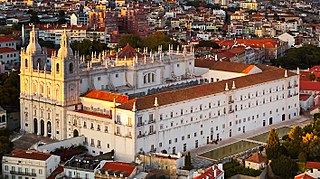
The Church and Monastery of São Vicente de Fora, meaning "Monastery of St. Vincent Outside the Walls", is a 17th-century church and monastery in the city of Lisbon, Portugal. It is one of the most important monasteries and mannerist buildings in the country. The monastery also contains the royal pantheon of the Braganza monarchs of Portugal.
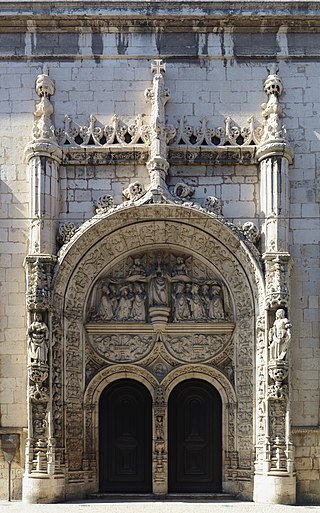
The Church of Nossa Senhora da Conceição is a church in the civil parish of Madalena, in the municipality of Lisbon.
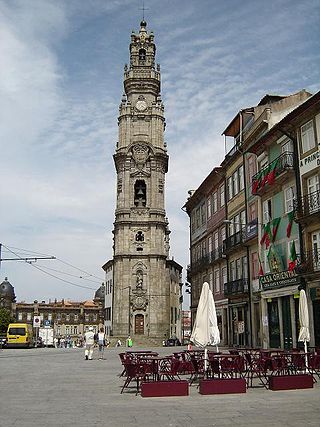
Nicolau Nasoni was an Italian artist and architect mostly active in Portugal.

St. Julian's Church is an 18th-century church located on the Praça de Bocage in Setúbal, Portugal. It is the main church (matriz) of the city classified as National Monument in 1910.

Gregório Lopes was one of the most important Renaissance painters from Portugal.

Jorge Afonso was a noted Portuguese Renaissance painter.

Josefa de Óbidos was a Spanish-born Portuguese painter. Her birth name was Josefa de Ayala Figueira, but she signed her work as "Josefa em Óbidos" or "Josefa de Ayalla". All of her work was executed in Portugal, her father's native country, where she lived from the age of four. Approximately 150 works of art have been attributed to Josefa de Óbidos, making her one of the most prolific Baroque artists in Portugal.

Cristóvão Lopes was a Portuguese painter.

The Cathedral Basilica of Salvador, officially dedicated to the Transfiguration of Christ and named Primatial Cathedral Basilica of the Transfiguration of the Lord is the seat of the Archbishop of the city of Salvador, in the State of Bahia, in Brazil. The Archbishop of Salvador is also ex officioPrimate of Brazil. The structure was built by the Society of Jesus as part of a large Jesuit monastic and educational complex. The current church is the built on the site, and was consecrated in 1654. After the expulsion of the Jesuits from Brazil in 1759 the school and church were transferred to the Archbishopric of Bahia. Archbishop Augusto Álvaro da Silva ordered the demolition of the existing cathedral of Salvador in 1933 to construct a tram line, and elevated the existing Jesuit structure to the status of basilica.
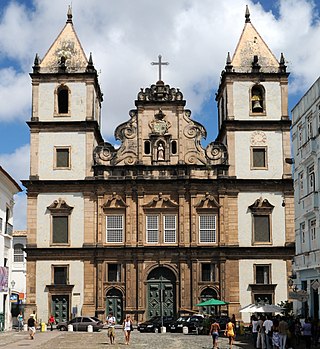
The São Francisco Church and Convent of Salvador is located in the historical centre of Salvador, in the State of Bahia, Brazil. The ornate Church of the Third Order of Saint Francis sits adjacent to the convent. The friars of the Franciscan Order arrived in Salvador in 1587 and constructed a convent and church on the site. This structure was destroyed by the Dutch during the Dutch invasions of Bahia in the next century; Father Vicente das Chagas initiated the current structure in 1686, which was completed in the 18th century. The Franciscan church and convent have the largest number of azulejos, 55,000, of any church in Latin America.
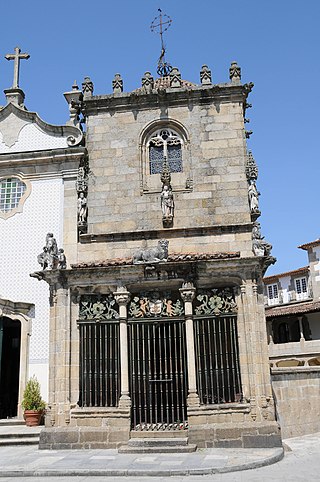
The Chapel of the Coimbras is a Manueline chapel located in the civil parish of São João do Souto, in the municipality of Braga. It has been classified as a National Monument since 1910.
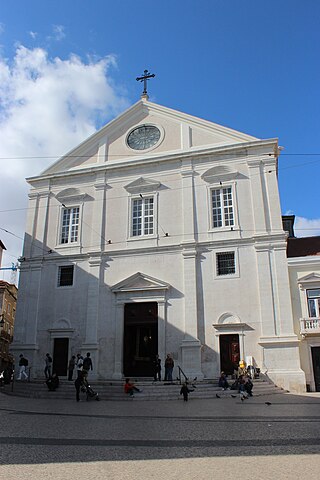
The Igreja de São Roque is a Catholic church in Lisbon, Portugal. It was the earliest Jesuit church in the Portuguese world, and one of the first Jesuit churches anywhere. The edifice served as the Society's home church in Portugal for over 200 years, before the Jesuits were expelled from that country. After the 1755 Lisbon earthquake, the church and its ancillary residence were given to the Lisbon Holy House of Mercy to replace their church and headquarters which had been destroyed. It remains a part of the Holy House of Mercy today, one of its many heritage buildings.
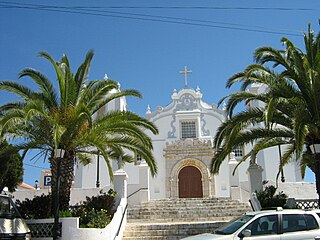
The Church of Saint James the Great is the principal church, in the civil parish of Estômbar in the municipality of Lagoa in the Algarve. Situated in the heart of the town, the church was consecrated to the invocation of Saint James, son of Zebedee.

Gilded woodcarving in Portugal is, along with azulejos, one of the country's most original and rich artistic expressions. It is usually used in the interior decoration of churches and cathedrals and of noble halls in palaces and large public buildings. An impressive collection of altarpieces are found in Portuguese churches. Originating in the Gothic era, Portuguese gilded woodcarving assumed a nationalist character during the 17th century and reached its height in the reign of King D. João V. In the 19th century it lost its originality and began to disappear with the end of the revival era.
The Ducal Palace of Vila Viçosa is a royal palace in Portugal, located in the civil parish of Nossa Senhora da Conceição, in the municipality of Vila Viçosa, in the Alentejo, situated about 150 km east of the capital Lisbon. It was for many centuries the seat of the House of Braganza, one of the most important noble houses in Portugal. Braganza was the ruling house of the Kingdom of Portugal from 1640 until 1910, when King Manuel II, titular head of the family, was deposed in the 5 October 1910 Revolution which brought in a Republican government.
Cristóvão de Morais was a 16th-century Portuguese court painter for the kings John III of Portugal and Sebastian I of Portugal. He painted numerous portraits for the kings, queens, and princes of Portugal.

Churches and Convents of Goa is the name given by UNESCO to a set of religious monuments located in Goa Velha, in the state of Goa, India, which were declared a World Heritage Site in 1986.
Diogo de Contreiras was a Portuguese Mannerist painter, active between 1521 and 1562. He has been identified as the painter referred to as the Master of Saint Quentin. The identification of de Contreiras as the Master of Saint Quentin was determined by Martin Soria (1957) and later reinforced by Vítor Serrão.
Veríssimo de Souza Freitas was an Afro-Brazilian painter of Colonial Brazil, noted for his paintings in various churches in Salvador and the immediate interior of Bahia region. He was an apprentice, assistant, and employee of Joaquim José da Rocha (1737-1807). De Freitas' mastery of trompe-l'œil painting follows in the tradition of Da Rocha. They worked simultaneously on numerous paintings, leading to confusion about authorship of some works. Freitas' ceiling paintings feature trompe l'oeil paintings with columns and arches, which continue to a central medallion with a painted sky.

The introduction of Mannerism in Brazil represented the beginning of the country's European-descended artistic history. Discovered by the Portuguese in 1500, Brazil was until then inhabited by indigenous peoples, whose culture had rich immemorial traditions, but was in every way different from the Portuguese culture. With the arrival of the colonizers, the first elements of a large-scale domination that continues to this day were introduced. During the founding of a new American civilization, the main cultural current in force in Europe was Mannerism, a complex and often contradictory synthesis of classical elements derived from the Italian Renaissance - now questioned and transformed by the collapse of the unified, optimistic, idealistic, anthropocentric world view crystallized in the High Renaissance - and of regional traditions cultivated in various parts of Europe, including Portugal, which still had in the earlier Gothic style a strong reference base. Over the years the current was added of new elements, coming from a context deeply disturbed by the Reformation, against which the Catholic Church organized, in the second half of the sixteenth century, an aggressive disciplinary and proselytizing program, the so-called Counter-Reformation, revolutionizing the arts and culture of the time.